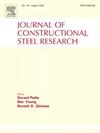Shear behavior of the panel zones in end-plate connection
IF 4
2区 工程技术
Q1 CONSTRUCTION & BUILDING TECHNOLOGY
引用次数: 0
Abstract
Three connections between the H-shaped steel column and the H-shaped steel beams were tested under cyclic loading to investigate the seismic behaviors of the panel zones, The studied parameters included different configurations of the connections (the thickness of the web plate, the height of the panel zone, and the thickness of the end plate). The failure modes, load-displacement characteristics and ductility were analyzed and discussed. Nonlinear finite element (FE) models were utilized to simulate the seismic behavior of the connections under cyclic loading. The results of the finite element were compared to the experimental results to verify the accuracy of the FE models in predicting the seismic performance of the connections. Using the validated finite element models, 18 case studies were performed to investigate the column-web thickness, the end plate thickness, the axial compression ratio, the thickness of the rib stiffener, and column-web heigh on the shear behavior of the connections. A calculation model for the shear strength of the panel zone of the end-plate connection was established. The established computational model was compared with calculations based on EC-3 and AISC 341, revealing that these codes do not explicitly account for the impact of local buckling in the panel zone. The proposed model improves the description of local failure modes in end-plate connections. Theoretical calculations are closely aligned with experimental results, demonstrating that the analytical model accurately predicts the shear load-bearing capacity of panel zone in end-plate connections.
求助全文
约1分钟内获得全文
求助全文
来源期刊

Journal of Constructional Steel Research
工程技术-工程:土木
CiteScore
7.90
自引率
19.50%
发文量
550
审稿时长
46 days
期刊介绍:
The Journal of Constructional Steel Research provides an international forum for the presentation and discussion of the latest developments in structural steel research and their applications. It is aimed not only at researchers but also at those likely to be most affected by research results, i.e. designers and fabricators. Original papers of a high standard dealing with all aspects of steel research including theoretical and experimental research on elements, assemblages, connection and material properties are considered for publication.
 求助内容:
求助内容: 应助结果提醒方式:
应助结果提醒方式:


